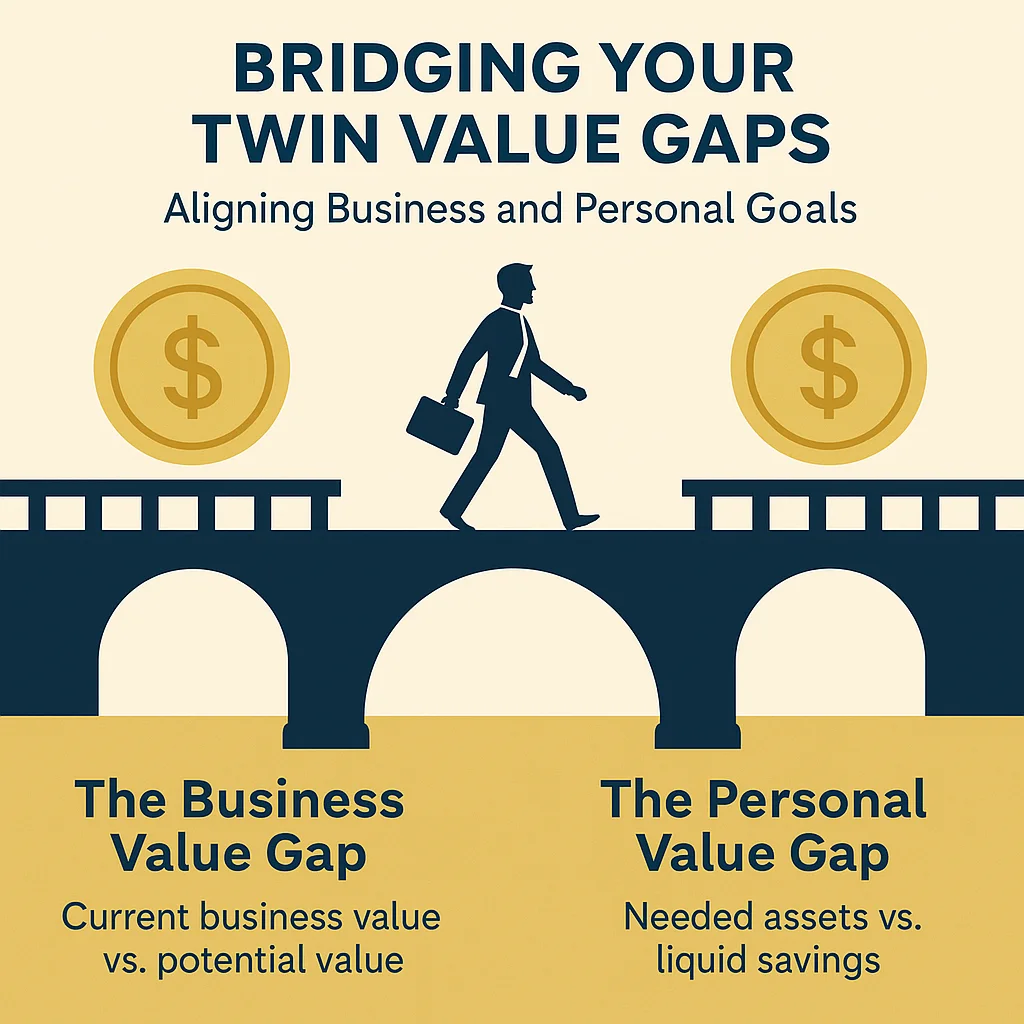
In the journey of business ownership, entrepreneurs often find themselves caught between two critical challenges: growing their business while simultaneously building personal wealth. This balancing act creates what experts call the “Twin Value Gaps” – a concept that, when properly understood, can transform how business owners approach both their company’s future and their personal financial goals.
The Twin Value Gaps represent two distinct but interconnected shortfalls that business owners face:

Research shows that better-run companies sell for higher multiples. The difference between what a business is worth today and what it could be worth with operational improvements represents a significant opportunity.
Enterprise value is driven by 18 key factors that act as “gears” in your business engine. These include growth, market size, market share, barriers to entry, differentiation, brand, margins, customer satisfaction, company financials, marketing, operations, management, HR, legal matters, and innovation.
By focusing on these drivers, you can potentially increase not just your company’s revenue and profit but also the multiple a buyer might pay for your business. This is particularly important since only 13% of business owners surveyed reported having value enhancement strategies as part of their exit plans, despite operational efficiency being critical for achieving a higher selling multiple.
The Personal Value Gap represents the difference between the retirement savings you need and what you currently have outside your business. For many business owners, their company represents their largest asset, but they haven’t saved enough liquid assets to fund their personal goals.
A comprehensive financial plan can help identify this gap by:
Working with a CERTIFIED FINANCIAL PLANNER™ professional can significantly improve your chances of building personal wealth. The planning process helps determine your retirement income needs and the savings required to support those needs.
The key to bridging these twin gaps lies in alignment. Most people aspire to happiness, but many discover what truly makes them happy only later in life. This realization often leads successful business owners to shift from pursuing success to seeking significance.
Consider this exercise: Write down what percentage of your waking hours is currently spent in each area of your life (business, health, family, etc.), then write down your ideal allocation. Most business owners realize they’re spending too much time at work and not enough on personal priorities.
Timing is crucial when monetizing your business. Three factors must align for a successful exit:
Market readiness is influenced by economic cycles, interest rates, and demographic trends. With baby boomers owning 66% of private businesses as of 2014, a potential glut of businesses for sale could depress prices in the coming years.
Additionally, there’s an inverse relationship between interest rates and business valuations. After 30 years of declining rates, economists expect interest rates to rise, potentially impacting business values negatively.
The time to act is now. While no one can predict the future with certainty, a window of opportunity may exist while various economic factors are in your favor. After all your efforts building your business, it makes sense to adopt the motto “Be Prepared.”
This preparation involves reassessing your work-life balance, developing a plan to align your business and personal financial goals, and finding the right team of experienced professionals to help you navigate whatever the future holds.
As Lewis Carroll wrote, “If you don’t know where you are going, any road will get you there.” Understanding and addressing your Twin Value Gaps gives you the roadmap to reach your destination.
For informational purposes only. This article does not constitute investment, legal, or tax advice. Please consult with qualified professionals regarding your specific situation.